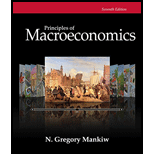
Sub part (a):
The nominal and real GDP and GDP deflator.
Sub part (a):
Explanation of Solution
The GDP is the summation of the monetary value of all the goods and services produced within the political boundary of a country, within a financial year. There are two different ways of calculating the GDP of the economy and they are the real GDP and the nominal GDP. The real GDP is the GDP calculated at the constant prices. There will be a base
The nominal GDP of the economy can be calculated by multiplying the quantity produced by the per unit price of the commodity. The quantity produced and price in 2016 was 100 quarts of milk and 50 quarts of honey. The prices were $1 and $2 respectively, for each quart. Thus, the nominal GDP of 2016 can be calculated as follows:
Thus, the nominal GDP of 2016 is $200.
Similarly, the quantity produced and price in 2017 was 200 quarts of milk and 100 quarts of honey. The prices were $1 and $2, respectively. Thus, the nominal GDP of 2017 can be calculated as follows:
Thus, the nominal GDP of 2017 is $400.
Similarly, the quantity produced in 2018 was 200 quarts of milk and 100 quarts of honey but the prices increased to $2 and $4, respectively. Thus, the nominal GDP of 2018 can be calculated as follows:
Thus, the nominal GDP of 2018 is $800.
The real GDP can be calculated by multiplying the quantity produced with the base year price level. Since the base year is 2016, the nominal GDP of 2016 will be equal to the real GDP of 2016, which is equal to $200.
In the case of 2017, the real GDP can be calculated by multiplying the 2017 quantity with the 2016 price as follows:
Thus, the real GDP of 2017 is $400.
In the case of 2018, the real GDP can be calculated by multiplying the 2018 quantity with the 2016 price. Since there is no change in the quantity produced in 2018 and 2017 in the two commodities of milk and honey, there will be no change in the real GDP of the two years and thus, the real GDP of 2018 will be the same as 2017, which is $400.
The GDP deflator is the implicit price deflator. It can be calculated by dividing the nominal GDP with the real GDP and multiplying the value with 100 as follows:
Thus, by substituting the values of nominal and real GDP in the equation, we can calculate the GDP deflator as follows:
Thus, the GDP deflator in 2016 is 100. Similarly, the GDP deflator for 2017 can be calculated as follows:
Thus, the GDP deflator in 2017 is also 100.
The GDP deflator for 2018 can be calculated as follows:
Thus, the GDP deflator in 2018 is 200.
These values can be tabulated as follows:
Table 1
| Year | Nominal GDP | Real GDP | GDP Deflator |
| 2016 | $200 | $200 | 100 |
| 2017 | $400 | $400 | 100 |
| 2018 | $800 | $400 | 200 |
Concept introduction:
Gross Domestic Product (GDP): It is the summation of the monetary value of all the goods and services produced within the political boundary of a country, within a financial year.
GDP deflator: It is an implicit price deflator.
Sub part (b):
The Percentage change in nominal and real GDP and GDP deflator.
Sub part (b):
Explanation of Solution
The percentage change in nominal GDP can be calculated by the following formula:
Thus, by substituting the values for the current year and previous year, we can calculate the percentage change in the nominal GDP as follows:
Thus, the percentage change in nominal GDP of 2017 is 100 percent.
Thus, the percentage change in nominal GDP of 2018 is also 100 percent.
Similarly, the percentage change in real GDP and GDP deflator can be calculated as follows:
The percentage change in real GDP of 2017 is 100 percent.
The percentage change in real GDP of 2018 is 0 percent.
The percentage change in the GDP deflator can be calculated as follows:
Thus, the percentage change in GDP deflator of 2017 is 0 percent.
Thus, the percentage change in GDP deflator of 2018 is 100 percent.
The prices in the economy remain the same in the year 2016 and 2017, which leads to no change in the percentage change in the GDP deflator. This is why the GDP deflator percentage change is zero. Similarly, the output levels remain the same in the years 2017 and 2018, which leads to the value of percentage change in the real GDP to remain at zero.
Concept introduction:
Gross Domestic Product (GDP): It is the summation of the monetary value of all the goods and services produced within the political boundary of a country, within a financial year.
GDP deflator: It is an implicit price deflator.
Sub part (c):
Economic well-being.
Sub part (c):
Explanation of Solution
The economic well-being increased much larger in the year of 2017, when compared to 2016 and 2018. This result is obtained from the analysis of the data that the real GDP remained the same in 2018 as the real GDP in the 2017. Thus, there were no changes in the real GDP after 2017. But after 2016, the real GDP increased from $200 to $400 in 2017. This means that the well-being rose more in 2017. Another reason why the well-being didn’t rise in 2018 was the price hike. The output remained the same, whereas prices doubled.
Concept introduction:
Gross Domestic Product (GDP): It is the summation of the monetary value of all the goods and services produced within the political boundary of a country, within a financial year.
Want to see more full solutions like this?
Chapter 10 Solutions
Bundle: Principles of Macroeconomics, Loose-leaf Version, 7th + MindTap Economics, 1 term (6 months) Printed Access Card
- how commond economies relate to principle Of Economics ?arrow_forwardCritically analyse the five (5) characteristics of Ubuntu and provide examples of how they apply to the National Health Insurance (NHI) in South Africa.arrow_forwardCritically analyse the five (5) characteristics of Ubuntu and provide examples of how they apply to the National Health Insurance (NHI) in South Africa.arrow_forward
- Outline the nine (9) consumer rights as specified in the Consumer Rights Act in South Africa.arrow_forwardIn what ways could you show the attractiveness of Philippines in the form of videos/campaigns to foreign investors? Cite 10 examples.arrow_forwardExplain the following terms and provide an example for each term: • Corruption • Fraud • Briberyarrow_forward
- In what ways could you show the attractiveness of a country in the form of videos/campaigns?arrow_forwardWith the VBS scenario in mind, debate with your own words the view that stakeholders are the primary reason why business ethics must be implemented.arrow_forwardThe unethical decisions taken by the VBS management affected the lives of many of their clients who trusted their business and services You are appointed as an ethics officer at Tyme Bank. Advise the management regarding the role of legislation in South Africa in providing the legal framework for business operations.arrow_forward
- Tyme Bank is a developing bank in South Africa and could potentially encounter challenges similar to those faced by VBS in the future. Explain five (5) benefits of applying business ethics at Tyme Bank to prevent similar ethical scandals.arrow_forward1.3. Explain the five (5) ethical challenges that can be associated with the implementation of the National Health Insurance (NHI) in South Africa.arrow_forward1.2. Fourie (2018:211) suggests that Ubuntu emphasises the willingness to share and participate in a community. However, it does not privilege the community over the dignity and life of the individual. With the above in mind, discuss how the implementation of the National Health Insurance (NHI) is a way to uphold the concept of Ubuntu.arrow_forward
 Economics (MindTap Course List)EconomicsISBN:9781337617383Author:Roger A. ArnoldPublisher:Cengage Learning
Economics (MindTap Course List)EconomicsISBN:9781337617383Author:Roger A. ArnoldPublisher:Cengage Learning
 Macroeconomics: Principles and Policy (MindTap Co...EconomicsISBN:9781305280601Author:William J. Baumol, Alan S. BlinderPublisher:Cengage Learning
Macroeconomics: Principles and Policy (MindTap Co...EconomicsISBN:9781305280601Author:William J. Baumol, Alan S. BlinderPublisher:Cengage Learning Principles of Economics, 7th Edition (MindTap Cou...EconomicsISBN:9781285165875Author:N. Gregory MankiwPublisher:Cengage Learning
Principles of Economics, 7th Edition (MindTap Cou...EconomicsISBN:9781285165875Author:N. Gregory MankiwPublisher:Cengage Learning Essentials of Economics (MindTap Course List)EconomicsISBN:9781337091992Author:N. Gregory MankiwPublisher:Cengage Learning
Essentials of Economics (MindTap Course List)EconomicsISBN:9781337091992Author:N. Gregory MankiwPublisher:Cengage Learning Principles of Economics (MindTap Course List)EconomicsISBN:9781305585126Author:N. Gregory MankiwPublisher:Cengage Learning
Principles of Economics (MindTap Course List)EconomicsISBN:9781305585126Author:N. Gregory MankiwPublisher:Cengage Learning





